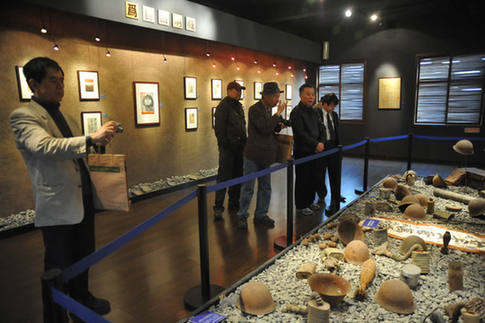A Descendant of Nanjing
In addition to the daily routine during the month before he set off for the exhibition in Japan, Wu received visits from groups of a dozen or more Japanese NGO representatives. Experts and scholars from domestic colleges and universities and research institutes also came by almost every day.
“I am neither an offspring of the victims of the Nanjing Massacre nor a descendant of soldiers that participated in the war. My family moved to Nanjing after the war was over,” Wu said, adding, “However, I was born and raised in Nanjing, so I am a descendant of Nanjing City.”
 |
|
In 2010, members of the Meishin Association from Japan visited the Nanjing Private Museum of the Chinese War of Resistance against Japanese Aggression. |
Memories of Ordinary People
All exhibits in the museum come from people who lived there, and every item has its story.
One is an old, yellowed business card. It shows the name and title: Chen Zhongzhu, Commander of the Fourth Column of Guerrilla Forces on the Border Area of Shandong, Jiangsu and Anhui Provinces. General Chen excelled in guerrilla warfare against Japanese invaders. He died in early 1941 after taking six bullets.
“The back of the card bears the general’s sole extant handwriting. As soon as it came into our possession, we started looking for his relatives,” Wu said. In August 2012, Chen’s daughter, having heard about the card, made a special trip from Australia to the museum. She wrote in the visitor’s book: “Dear father, seeing your handwriting and seal today reminds me of the past, as if I saw you again.”
The exhibits are not intended to highlight the cruelty of war, but rather the life and destiny of the people of that time. They include letters and bills, armbands of the neighborhood team members who buried the dead during the Nanjing Massacre, more than 300 maps that the Japanese army used during the war, and Chinese soldiers’ daily-use articles.
Chinese American writer Iris Chang filmed much precious video data during her interviews in 1995 with survivors of the Nanjing Massacre when doing research for her book The Rape of Nanking. After her death, Chang’s parents donated it all to Wu’s museum, so signifying their trust and confidence in him.
Wu’s museum also serves as a platform for people-to-people communication. It receives many foreign visitors every year, the majority of them Japanese, with Americans and Germans a close second. “Many Japanese NGOs make a point of including my museum on their itineraries when visiting China,” Wu said. “During exchanges in the past few years, I have found that overseas NGOs are noticeably mature compared with their relatively inexperienced Chinese counterparts. But I think Chinese NGOs should have their voice with regards to historical issues between China and Japan.”
